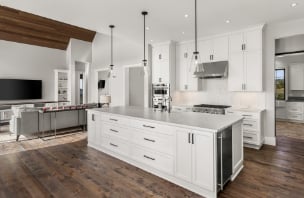

Engineered hardwood has the timeless elegance of solid hardwood and the practicality of laminate flooring, yet, it establishes its own identity with its own stability and versatility.
Engineered hardwood’s attributes set it apart in the diverse world of flooring, offering a distinct advantage that positions engineered hardwood as a category unto itself.
What is Engineered Hardwood?
Engineered hardwood is a type of flooring that combines a thin layer of real wood veneer on top of a stable core, typically made from plywood or HDF (high-density fiberboard). The ply layers minimize the risk of warping or bowing, and maintain the floor’s flatness over time.
The number of ply layers, typically ranges from three to twelve, and the more layers generally mean better stability. The increased thickness provides additional resistance against environmental changes.
In essence, the ply layers act as the backbone of engineered hardwood, providing the foundation for a durable, long-lasting floor that maintains its beauty and structural integrity in various conditions.
HDF allows engineered hardwood to withstand changes in humidity and temperature better than solid hardwood, making it suitable for a wide range of environments.
With a variety of finishes and wood species available, engineered hardwood provides the flexibility to match any decor, making it a popular choice for homeowners looking to mix style with durability in their flooring.
How Ply Numbers Influence a Floor’s Stability
Influence of room size and function
Larger spaces and areas subjected to heavy foot traffic, such as living rooms) benefit from flooring with a higher number of ply layers. The added thickness provides extra stability and durability, which accommodates the increased activity without compromising the floor’s integrity.
Smaller rooms or spaces with lighter usage might not require as many ply layers, allowing for more flexibility in flooring choices without sacrificing performance.
Climate and humidity
If you live in an area with high humidity levels or significant seasonal changes, your floor might need more ply layers. More layers minimize expansion and contraction versus if you’re in an area with fewer fluctuations in moisture levels.
Quality of Ply Layers and Floor Stability
High-quality ply materials ensure that each layer contributes effectively to the floor’s resistance against environmental factors such as humidity and temperature fluctuations.
Material quality and ply integrity
High-grade materials ensure that each ply layer possesses the necessary strength and moisture resistance to withstand environmental changes. This quality directly influences the floor’s ability to remain stable and maintain its appearance over time, minimizing issues like warping or splitting.
The selection of premium materials for ply construction not only enhances the floor’s aesthetic appeal but also its longevity, making it a crucial factor in flooring stability.
Adhesive quality and layer bonding
High-quality adhesives create a strong bond between layers, preventing them from separating or shifting under pressure or changes in humidity. It’s vital for maintaining the structural integrity and performance of the floor.
Investing in engineered hardwood floors with superior adhesive quality also means investing in a floor designed to last.
What Happens If You Don’t Have Enough Ply Layers?
Inadequate ply layers in engineered hardwood flooring can lead to many issues that compromise both the functionality and aesthetic of the floor.
More vulnerable to warping
Engineered hardwood floors with inadequate ply layers face an increased susceptibility to warping. The lack of sufficient structural support makes these floors more prone to bending or twisting in response to environmental changes.
As the wood expands or contracts with fluctuations in humidity and temperature, floors with fewer ply layers cannot effectively distribute the tension, leading to distorted shapes and compromised stability.
This not only affects the floor’s appearance but can also result in uneven walking surfaces, posing safety risks.
Risk of moisture damage
With fewer barriers to prevent moisture penetration, engineered hardwood floors are more vulnerable to water and humidity seeping into the wood. This can lead to swelling, mold growth, and rot.
Moisture damage will not only result in costly repairs but can also become a breeding ground for mold, which means risking your and your family’s health.
Impact of Ply Layer Thickness On Engineered Hardwood Floor Stability
Relationship between thickness and durability
Thicker ply layers provide more structural integrity and resilience to the flooring, which means enhancing its ability to withstand wear and tear over time. This increased durability is crucial for high-traffic areas where the floor is subjected to constant use.
Thicker layers also offer better insulation and soundproofing qualities, contributing to a more comfortable and quiet living environment. Therefore, the thickness of the ply layers is a key factor in extending the lifespan and maintaining the appearance of engineered hardwood floors.
Thickness versus number of layers
When considering thickness versus the number of layers, it’s essential to understand that both aspects contribute to the floor’s stability but in different ways.
While thicker ply layers provide a solid base and greater durability, the number of layers enhances the floor’s stability against environmental changes. A higher number of thinner layers, arranged in a cross-layered construction, can offer superior stability by effectively distributing tension and reducing the risk of warping.
Consequently, the optimal engineered hardwood flooring solution balances thickness for durability with a sufficient number of layers for stability, tailored to the specific needs of the environment and usage demands.
The Stability of Your Floor Begins with Ply Layers
As a provider of high-quality engineered hardwood floors, 50Floor stands at the forefront of offering products that not only embody aesthetic appeal but also focus on the importance of structural integrity through optimal ply layer construction.
With a focus on the highest standards of material selection and craftsmanship, we ensure that each engineered hardwood floor boasts the perfect balance of beauty and stability.





